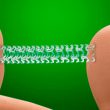Courtesy of Dr. Rodrigo Abreu. INTRODUCTION Bifurcation lesion treatment has evolved considerably in the last years: from balloon angioplasty (with high occlusion and restenosis rates) to bare metal stent angioplasty (with a procedural success around 86% and major adverse cardiac events [MACE] at 1 year around 32%). The subsequent emergence of drug-eluting stents (DES) reduced...
DES: Best Option in Saphenous Vein Grafts
These results confirm that, despite being used less and less worldwide, DES (drug eluting stents) are the best option in saphenous vein grafts. Saphenous vein graft atherosclerosis has a different pathophysiology to that of native arteries, and PCI in this context is less effective because of high risk of friable thromboembolic material, faster plaque...
Current Bare-Metal Stents: Similar to DES in the Very Long-Term
The largest randomized trial in history found no difference in the primary endpoint of death and nonfatal infarction between current conventional stents and drug-eluting stents at over 5 years in patients with stable or unstable coronary disease. As expected, NORSTENT did find a difference in revascularization rates between both groups. This study presented at the...
Primary PCI: Similar Results During Day and Night
Patients with ST-segment elevation myocardial infarction included in the CHAMPION PHOENIX trial admitted during nights, weekends, and holidays presented the same prognosis and good clinical outcomes as those who were admitted during regular daytime hours. Prior studies had indicated that off-hours admission was associated with worse outcomes; however, this particular analysis contradicts such a...
Prasugrel vs. Ticagrelor in Primary Angioplasty
The choice of prasugrel or ticagrelor for patients with acute myocardial infarction undergoing primary angioplasty makes no difference, at least in the short term. This study was terminated prematurely and thus lost statistical power, which means that any interpretation of the lack of difference between the two antiplatelet drugs must take into account such...
BVS: Safe and Effective in the Infrapatellar Area
Courtesy of Dr. Carlos Fava. Drug-eluting stents (DES) have shown mid-term benefit in lesions below the knee (BTK) by reducing the rate of acute occlusion and restenosis in type A and B lesions. However, failure to recover the self-regulatory functions of the local vessel could hinder future revascularization. Drug-eluting bioresorbable scaffolds (BVS) could be a solution to this problem....
Angiosome: Is It Feasible in Critical Limb Ischemia?
Courtesy of Dr. Carlos Fava. Critical limb ischemia (CLI) accompanied by tissue loss entails high risk of amputation. At present, there is substantial evidence in favor of revascularization by PCI according to the angiosome concept, but the feasibility of this treatment remains unclear. 161 compromised limbs were analyzed in 160 patients with foot...
ABSORV at Long Term in Daily Practice Lesions
This work reports one year outcomes of the BVS Expand registry. Multiple studies have shown the safety and feasibility of the everolimus eluting bioresorbable scaffold ABSORB (Abbott Vascular, Santa Clara, California), but medium and long term data are limited and only on simple lesions. This is a prospective single-center registry assessing ABSORB performance in...
Beta-Blockers for Revascularized Patients: To Prescribe or Not?
This study examines predictors and outcomes associated with the prescription of beta-blockers at discharge after a successful coronary angioplasty in patients with stable chronic angina WITHOUT prior history of acute myocardial infarction or heart failure. The benefit of beta-blockers in patients with acute myocardial infarction or systolic heart failure is well documented. However, their...
Peri-Procedural MI Reduction: Cangrelor or Clopidogrel?
Cangrelor is an intravenous P2Y12 inhibitor approved to reduce peri-procedural ischemic events in patients undergoing PCI that have not previously received any other P2Y12 inhibitor. The CHAMPION PHOENIX trial randomized a total of 11,145 patients to cangrelor vs. clopidogrel. The study sought to explore the effect of cangrelor on peri-procedural acute myocardial infarction...





